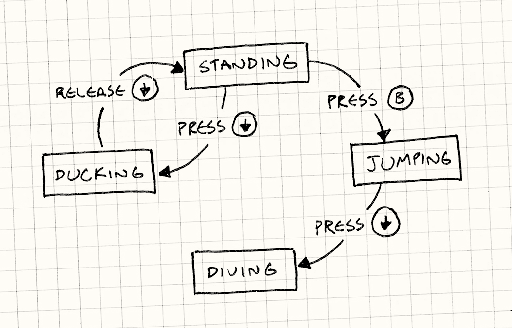Unity 下简易状态机的实现
国庆到处都是人,我的建议是要么出国旅游,要么就宅在家把时间留给自己或家人。朋友约我去星巴克坐着重构代码,想想也是程序猿之间才有的默契。
关于状态机,我想都知道它很常用,就像单例一样,缺了它们,我们在游戏编程世界里呼吸都不畅快。网上也有很多大神写的状态机,比如PlayMaker这样重量级的插件,功能很强大,依赖也不少。程序猿的胃口有时候就是很挑剔,吃惯了大鱼大肉,也想整点清粥小菜。应该有很多朋友跟我一样,希望有一套简易的状态机实现,每行代码自己都了如指掌,实现我们一些简单的状态控制的需求。In hand,伸手就来的方便!
下面是我的实现,有错误或者low的地方,欢迎大家留言,一起进步吧!
讲到状态机,首当其冲的肯定是状态,我们把状态细分为不同的阶段,每个阶段处理各自的事情。状态里最基本要有OnEnter,OnExit,OnUpdate三个阶段的处理。在 Unity下,我把OnUpdate分得更细,原因在于有些操作需要放在特定的帧下面执行,比如相机的跟随,角色的移动等。
/// <summary>
/// 状态基类.
/// </summary>
public class FiniteState {
public string Name {
get {
return GetType().Name;
}
}
public virtual void OnEnter(object context){}
public virtual void OnExit(object context){}
public virtual void OnUpdate(object context){}
public virtual void OnFixedUpdate(object context){}
public virtual void OnLateUpdate(object context){}
}
}Transition是有限状态机里面不可或缺的三要素之一,它主要约束状态之间的过渡,A和B两个状态之间是否存在过渡关系,以及过渡的条件是什么,就由FiniteStateTransition来决定。
using UnityEngine;
using System.Collections;
namespace PLY.StateMachine{
/// <summary>
/// 状态机过渡约束基类.
/// </summary>
public class FiniteStateTransition {
public string EventName;
public string LastStateName;
public string NextStateName;
public FiniteStateTransition(string eventName, string lastStateName, string nextStateName){
EventName = eventName;
LastStateName = lastStateName;
NextStateName = nextStateName;
}
}最后是管理所有状态及其之间 Transition关系的状态机,它提供映射 Transition的方法,接收触发事件并过渡到对应的状态。
using UnityEngine;
using System.Collections;
using System.Collections.Generic;
namespace PLY.StateMachine {
/// <summary>
/// 有限状态机基类.
/// </summary>
[System.Serializable]
public class FiniteStateMachine : MonoBehaviour {
private object Context_;
public string CurrentStateName = "EmptyState";
private FiniteState CurrentState_;
protected FiniteState CurrentState{
get{
return CurrentState_;
}
set{
CurrentState_ = value;
CurrentStateName = CurrentState_.Name;
}
}
protected FiniteState defaultState;
private Dictionary<string, FiniteState> allStates_ = new Dictionary<string, FiniteState>();
private List<FiniteStateTransition> allTransitions_ = new List<FiniteStateTransition>();
protected virtual void Init(){}
protected void AddState(FiniteState state){
allStates_.Add(state.Name, state);
}
protected void RemoveState(FiniteState state){
allStates_.Remove(state.Name);
}
/// <summary>
/// 添加过渡.
/// </summary>
/// <param name="eventName">Event name.</param>
/// <typeparam name="T1">源状态类型.</typeparam>
/// <typeparam name="T2">目标状态类型.</typeparam>
protected void AddTransition<T1,T2>(string eventName)where T1 : FiniteState where T2 : FiniteState{
string lastStateName = typeof(T1).Name;
string nextStateName = typeof(T2).Name;
FiniteStateTransition transition = new FiniteStateTransition(eventName, lastStateName, nextStateName );
allTransitions_.Add(transition);
}
protected void AddTransition(FiniteStateTransition transition){
allTransitions_.Add(transition);
}
protected void RemoveTransation(FiniteStateTransition transition){
allTransitions_.Remove(transition);
}
public void SetContext(object context){
Context_ = context;
}
/// <summary>
/// 发送事件,触发下一状态的切换
/// </summary>
/// <param name="eventName">事件名.</param>
public void SendEvent(string eventName){
for (int i = 0; i < allTransitions_.Count; i++) {
FiniteState nextState;
if (TryGetNextStateByEventName(allTransitions_[i], eventName, out nextState)){
ChangeState(nextState);
break;
}
}
}
private bool TryGetNextStateByEventName(FiniteStateTransition transation, string eventName, out FiniteState state){
state = null;
if (CurrentState == null || !CurrentState.Name.Equals(transation.LastStateName)) return false;
if (!eventName.Equals(transation.EventName)) return false;
return (allStates_.TryGetValue(transation.NextStateName, out state));
}
/// <summary>
/// 切换状态.
/// </summary>
/// <param name="newState">New state.</param>
private void ChangeState(FiniteState newState){
if (CurrentState != null){
CurrentState.OnExit(Context_);
}
else{
Debug.LogError("当前状态为空,退出状态失败!", gameObject);
}
CurrentState = newState;
if(CurrentState != null){
CurrentState.OnEnter(Context_);
}
else{
Debug.LogError("当前状态为空,进入状态失败!", gameObject);
}
}
private void SetDefaultToCurrent(){
CurrentState = defaultState;
}
private void Awake(){
Init();
SetDefaultToCurrent();
}
private void Start () {
if (CurrentState != null){
CurrentState.OnEnter(Context_);
}
}
private void Update () {
if (CurrentState != null){
CurrentState.OnUpdate(Context_);
}
}
private void FixedUpdate(){
if (CurrentState != null){
CurrentState.OnFixedUpdate(Context_);
}
}
private void LateUpdate(){
if (CurrentState != null){
CurrentState.OnLateUpdate(Context_);
}
}
}
}
下面是我的测试用例了,简单写了一个关于锁的状态机,两种状态:锁住,未锁住。
using UnityEngine;
using System.Collections;
using PLY.StateMachine;
public class PlayerStateMachine : FiniteStateMachine{
protected override void Init (){
Locked state1 = new Locked();
AddState(state1);
Unlocked state2 = new Unlocked();
AddState(state2);
defaultState = state1;
AddTransition<Locked, Unlocked>("UNLOCK");
AddTransition<Unlocked, Locked>("LOCK");
}
}
public class Locked : FiniteState{
public override void OnEnter (object target){
Player owner = target as Player;
owner.Show(true);
}
public override void OnExit (object target){}
public override void OnUpdate (object target){}
}
public class Unlocked : FiniteState{
public override void OnEnter (object target){
Player owner = target as Player;
owner.Show(false);
}
public override void OnExit (object target){}
public override void OnUpdate (object target){}
}using UnityEngine;
using System.Collections;
using PLY.StateMachine;
public class Player : MonoBehaviour{
public FiniteStateMachine StateMachine;
private bool isShowingLockedView_;
private Texture LockTex_;
private Texture UnlockTex_;
private void Awake(){
StateMachine.SetContext(this);
LockTex_ = Resources.Load("tex_locked") as Texture;
UnlockTex_ = Resources.Load("tex_unlocked") as Texture;
}
private void OnGUI(){
if(GUI.Button(new Rect(0,0,120,30), "UNLOCK")){
StateMachine.SendEvent("UNLOCK");
}
if(GUI.Button(new Rect(0,40,120,30), "LOCK")){
StateMachine.SendEvent("LOCK");
}
if(isShowingLockedView_){
GUI.Label(new Rect(Screen.width/2,50,128,128), new GUIContent(LockTex_));
}
else{
GUI.Label(new Rect(Screen.width/2,50,128,128), new GUIContent(UnlockTex_));
}
}
public void Show(bool isLocked){
isShowingLockedView_ = isLocked;
}
}






















 1015
1015

 被折叠的 条评论
为什么被折叠?
被折叠的 条评论
为什么被折叠?








